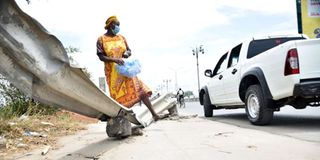Research can put an to end vandalism

A woman steps over damaged guard rails at Nyali Bridge in Mombasa in this picture taken on September 10, 2020. The vandalised guard rails pose a great risk to motorists, pedestrians and other users of the busy road.
What you need to know:
- Some countries have developed and deployed spatial tools to monitor vandalism.
- For Kenya to sustainably solve vandalism, the crime detection units have to venture into crime-related research and development.
State entities continue to grapple with vandalism, a crime often seen as inconsequential but has pronounced economic damage where utilities such as electricity cables, street poles and lights, traffic lights, guard rails, road signs and drainage slabs are damaged.
Kenya’s struggle with vandalism, however, may be explained by a public understanding of the crime that has narrowly focused on approaches looking at patterns of where vandalism events occur without venturing into in-depth root-cause analysis.
Several studies, which have integrated social media and GIS data, have led to clear understanding of current and potential patterning of this crime.
In a paper published recently, spatial regression models on available crime data were used to show that the presence of collective resources, such as public property in parks, is a key factor in affecting where vandalism has relatively high rates.
Relatedly, a much-cited paper demonstrated that public resources can not only attract criminals but also potentially some areas, such as parks, could easily be used to hide destruction of property or as venues for individuals to gather and conduct vandalism.
Where studies have looked at geographic and other factors, contextual variables, including what is present in a given place, such as public or even some private resources, socioeconomic status, cultural status and environmental factors have all been correlated with the crime.
A recent study using a combination of Twitter, Foursquare and spatial context information from Google Street View reported successful visualisation of reported crime and developed a model to allow pattern analysis of where given crimes were likely to occur based on more context-driven information provided by descriptions.
Monitor vandalism
Contextual information — which is not limited to demographic data of who perpetrated the given vandalism — from reporters of crime is a stronger predictor of where vandalism is likely to occur than even the more common or traditionally used data used by police.
Some countries have gone further to develop and deploy spatial tools to enable their cities and other public entities to more easily monitor vandalism while providing some analytical capability in trying to understand key factors that cause it or its likely presence in places.
Preliminary reports from Sweden show public data on crime statistics that are spatially referenced has hastened the authorities’ understanding of the geography of crimes.
For Kenya to sustainably solve vandalism, the crime detection units have to venture into crime-related research and development and equip inspectors from state entities or even police with integrated public crime analysis tools.
That would not only visualise crime and generate data outputs like summary statistics and time intervals the location of acts of crime but also forecast it.
Other techniques may include “stochastic Bayesian modeling”, which, under different spatio-temporal possibilities, could allow better estimation.
Mr Onyango is a Global Impact fellow at Moving Worlds Institute (MWI). [email protected]





